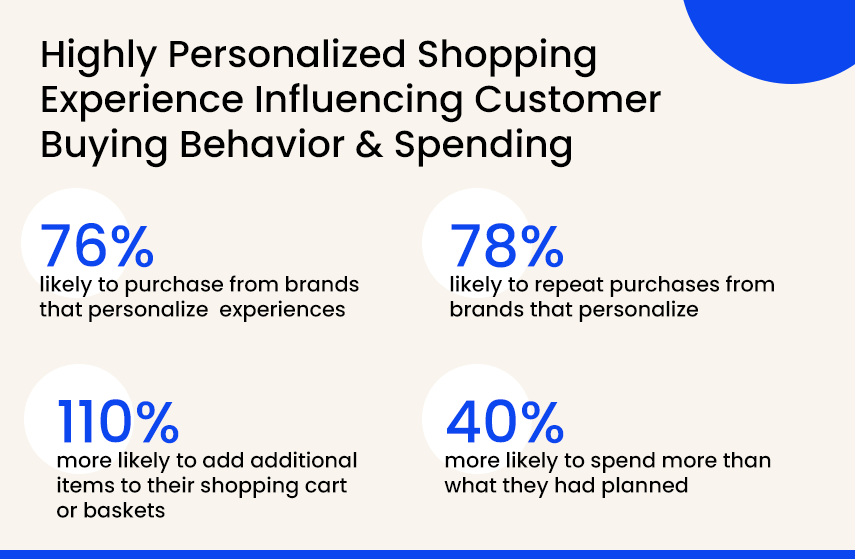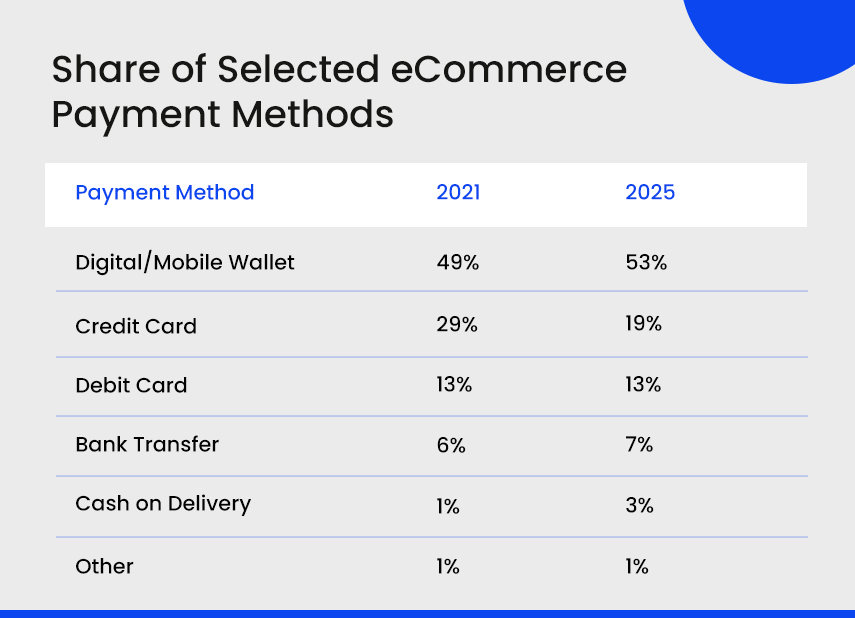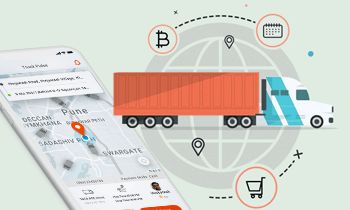Retail is an ultra-competitive industry today. Intense competition, changing consumer shifts from offline to online, hyper-personalization, and supply chain complexities have heaped pressure on retailers. They are responding back with unwavering efforts to meet changing market needs.

Keeping up with future retail trends can help retailers in many ways, such as –
- Analyze the changing consumer shopping habits
- Understand the key factors that enhance operational efficiency
- Reinvent offerings to meet consumer expectations
- Modernize retail internal and external operations
- Build winning strategies to create unique shopping journeys
- Outperform competitors in sales growth by 85%
- Increase customer engagement and satisfaction level
Here are the top 10 retail digital transformation trends that every retailer need to keep an eye on in 2023:
- Digitized In-store Experience is a Key Metric
- Hybrid Retailing: BOPO, ROPO, & More for Contactless Delivery
- Retail Data Analytics, Predictions, & Decisions
- Cost Optimization to Gain More Profits
- Personalization will be the New Brand Loyalty Factor
- Cashierless Shopping & Mobile Wallets are Here to Stay
- Workforce Empowerment to Enhance Shopping Journey
- Robotics and Automation in Retail
- Social Commerce and Omnichannel Retailing to Set New CX Standards
- Technological Advancements & Innovations Impact on Retail
Let’s take a more in-depth look at these 2023 digital transformation trends in retail industry.
1. Digitized In-store Experience is a Key Metric
Today, most shoppers turn to mobile apps or websites to research a product, compare similar products, and make a purchase decision. Statista predicted 8.1 trillion dollars in eCommerce sales by 2026. They tend to check online about products before making a purchase, even in physical stores. The meteoric rise of online shopping has modernized the in-store retail shopping experience.
When they shop in person, they do the following –
- Look out for various deals and discounts
- Compare prices of similar products
- Check real-time product availability
- 50% watch videos before visiting a store
Besides, no shopper wants to experience a frustrating digital experience. There are many competitors offering similar products and services. What shoppers do is, in the case of poor experience – move on to another retail competitor. Thus, value-added in-store experiences need sophisticated technology in place.
Retailers should identify the right technology considering their functional in-store environment. For instance, AI-powered digital signage in a brick-and-mortar store can do the following:
- Provide high-value product information to shoppers
- Provide data on the most eye-catching advertisement
- Let retailers know which areas of the store have the highest traffic flow
- Show tailored ads based on real-time customer demographics like age and gender
Decathlon, Gucci, and Ulta Beauty are the best retail digital transformation examples. They are providing personalized contactless in-store interactions by integrating digital solutions with existing systems.
Talking about Decathlon’s digital transformation in retail. They integrated various apps, systems, and data to enable an omnichannel shopping experience. Here are a few highlights of their digital retail transformation with record-breaking growth –
- eCommerce app offering personalized recommendations
- Cloud-based order management system
- Cashless check-out experience via mobile scan and pay approach
- Computer-vision enabled RFID tags on each item
- Optimized logistics, transportation, and supply chain functions
- Robotic process automation enabled inventory management system
Customers, thus, can experience seamless shopping journeys in digitized brick and mortar stores. That has a positive impact on retail business growth.
2. Hybrid Retailing: BOPO, ROPO, & More for Contactless Delivery
The retail digital transformation has molded hybrid consumers. They prefer convenient shopping methods and demand more efficient delivery methods.
- 59% of consumers are interested in the BOPIS model (Source)
- 63% would like to try BOPIS (Source)
- 83% prefer convenient shopping options (Source)
Why? Because it enables seamless integration of online and offline shopping operations. It enables convenience, quick services, and increased customer satisfaction. Customers do not have to worry about extra shipping fees or long delivery wait times. Plus, AI-powered tools make it possible to simplify the complex inventory management process.
Hybrid retailing is also known as the click-and-collect model. It lets retailers add a wide range of tailored shopping and delivery options for their customers at their fingertips. Here are a few of them –
- Curbside pickup or BOPAC, where customers receive their items outside the distribution center or store even without leaving their vehicle.
- Buy Online, Pick-up in Store (BOPO), where customers order products online or by the app before coming to a physical store for pick-up.
- Research Online, Purchase Offline (ROPO), where shoppers obtain relevant product information online and then make purchases in a physical store.
- Reserve Online, Pick-up in Store (ROPIS), in which customers order items for in-store pickup and don’t pay until they receive them.
- Appointment-based brick-and-mortar shopping, where shoppers book a particular time slot to shop in-store.
Retailers like Walmart, Petco, and Amazon plan to expand their fulfillment options to enable a sales-boosting shopping experience.
Looking at the rising number of hybrid shoppers (a whopping 80% rise), Amazon is eying to open 260 stores in the UK by 2024. This expansion will help Amazon in the following two ways:
- Bolster its local presence in the UK
- Bring online elements to physical stores
Retailers need to remodel their sales strategy and integrate digital capabilities supporting on-site fulfillment options.
3. Retail Data Analytics, Predictions, & Decisions
Keeping track of entire retail operations is essential. Retailers must track data related to sales, inventories, store shelves, prices, etc., on a daily basis. The only way to be sure about those areas is through retail data analytics.
It is the process of collecting and analyzing retail data to predict outcomes and make smart business decisions.
With retail data analytics, retailers can do the following:
Determine prices based on market demands, inventory levels, and activities of competitors. Walmart is spending millions of dollars on big data analytics to get quick insights into data.
Identify customers and provide personalized experiences – Retailers can track consumer journeys, habits, shopping behavior, and preferences. This provides personalized shopping recommendations to customers.
Predict spending and demand – Some algorithms analyze customer browsing behavior and spending patterns. This helps retailers to predict upcoming trends and stock up inventories for their business.
Pick out the highest ROI opportunities – By understanding the response of their marketing campaigns.
Retailers can turn data into actions using big data analytics and make smart decisions that elevate store capabilities, address issues, and improve their sales, performance, and brand loyalty.

4. Cost Optimization to Gain More Profits
In the current volatile landscape, every retailer faces mounting challenges associated with costs caused by price inflation, supply-demand issues, and regulatory compliance. Optimizing costs is something that retailers can focus on as a rigorous approach to cost reduction. Since eliminating costs is not possible, cost reduction is.
Cost optimization refers to delivering business value at the lowest possible cost using advanced technologies. It was the key contributor to helping retail businesses stay afloat and manage uncertainty during COVID-19. Henceforth, retailers must prioritize cost-optimization initiatives to see tangible results in less than a year and remain competitive in the market.
Retailers can optimize cost by –
- Creating a list of promising cost optimization opportunities
- Implementing computer vision-powered digital scanning solutions for retail operations and managing merchandise inventory
- Designing digital commerce fulfillment models to deliver orders on time and increase profitability
- Automating operations and increasing workforce efficiency to deliver amazing customer experience
- Creating a culture of collaboration, transparency, and accountability to manage the cost drivers
The need to reduce cost is imperative to drive business performance and operational excellence.
5. Personalization will be the New Brand Loyalty Factor
52% of today’s modern consumers expect personalized experiences from brands they love. Services like personalized touchpoints, transparency in stocks, and innovative offerings are important to them.
Retailers across different categories have managed to put in place personalization at scale. Amazon has led the way in delivering personalized experiences with real-time recommendations. Brands like ‘Nike by You’ a digital commerce platform, allows shoppers to customize pairs of shoes as per their preferences. It helped the brand to enhance the shopping experience as well as boost sales growth.
Consumers – as much as 32 percent – prefer to walk away in case of bad experiences and respond positively to a brand providing personalized experiences.

Retailers value personalization the greatest since it increases sales by 40% and fosters consumer loyalty. With tech-powered digital retail solutions, you can –
- Enhance customer engagement via AI-powered customer services,
- Gain insights into buyers’ behavioral clues and transactional data
- Uncover shoppers’ intent via computer-vision-based personalization metrics
- Make personalized recommendations across the entire shopper journey
- Analyze and measure the results across the entire retail marketing funnel
- Make smart data-driven business decisions and define strategies for the future
Personalization is a force multiplier for a company that operates in a physical world or is a digital native. Retailers must integrate digital elements to offer highly personalized experiences across channels.
6. Cashierless Shopping & Mobile Wallets are Here to Stay
Payment is becoming increasingly cashless, driven by a combination of rising demand from consumers for secure cashless options, innovations, and technology advancements.
A digital or mobile wallet is by far the most popular online payment method, accounting for half of global eCommerce transactions. It will continue its inexorable rise and bring billions of new customers to unified digital commerce platforms powered by digital wallets.

PayPal, Apple Pay, Google Pay, and American Express are one of the best examples of mobile wallets.
Talking about American Express, they invested heavily in mobile technology to improve customer satisfaction. Considering consumer expectations, especially Gen Z having distinct expectations, they launched a web version as well as a mobile app known as Amex Pay to enable payment of bills and taxes while delivering an exceptional customer experience.
Surprisingly, the global mobile payment market size is expected to be $11.83 trillion by 2028, offering untethered business growth opportunities to retailers. Such digital transformation in the payment industry and tech-savvy consumers’ expectations are revving the path toward cashless retail stores as well.
A report states that 60% of consumers consider checkout is the biggest pain point in brick-and-mortar shopping. Amazon recognized and responded to customer needs to simplify checkout processes. Amazon Go is a well-known convenient cashier-less store in the US. Indeed, the retail giant has futuristic plans to open more cashier-less stores in many countries.
A frictionless shopping experience enabled by cashier-less purchasing options – mCommerce, is the need of the hour. Retailers need to move towards this trend in 2023 and start preparing for its implementation.
7. Workforce Empowerment to Enhance Shopping Journey
A great in-store shopping experience hinges on your staff’s knowledge, way of engagement, and prompt answers. Retailers need to fill the knowledge gaps, provide formal training in using in-store equipment, and develop skills. This helps them perform at your expected level and deliver excellent customer service. That’s what workforce empowerment is all about.
A well-trained, tech-savvy, and knowledgeable workforce genuinely engages with customers. It helps your ultra-modern store sell more products. Moreover, arming your staff with digital tools helps them communicate better with customers and make shopping journeys unique.
The pandemic has transformed consumer shopping habits, and they have high expectations from retailers. The same holds true for the retail workforce. They want a supportive, digital, flexible, and collaborative environment to deal with multiple customers. As a retail business owner, it is your responsibility to empower your workforce to increase the productivity of your outlets.
8. Robotics and Automation in Retail
The retail industry is dependent mainly on back-end processes, including supply chain and logistics operations. However, most retailers face problems due to cumbersome systems, labor work, and manual and time-consuming processes.
Plus, margins are stressed from all sides in retailing, i.e., growing demands from suppliers to pass on raw materials, advertising costs, and higher costs to manage operations and human resources. At the same time, customers expect personalized services.
In this scenario, retailers must meet customer satisfaction across multiple geographies while optimizing costs and improving operational efficiencies. This is possible by integrating digital elements with offline operations and embracing advanced technologies like Robotics Process Automation, Cloud, Artificial Intelligence, IoT, etc., at scale.
Applications of retail automation are vast. Retailers can automate half of the internal activities like what Amazon did for warehousing, merchandising, and supply chain operations. It made headlines with its innovative concepts like Amazon Go and autonomous warehouse factories jam-packed with robots.
Here are some of the retail digital transformation use cases using automation:
- Efficient management and monitoring of inventory
- Automated merchandising with advanced planning system
- RPA-powered warehousing solution where automated robots manage product shipment operations
- Automated communication between stakeholders
- Using chatbots to deliver exceptional customer support
- Robots for loss prevention and security
- Automated POS systems and self-checkout systems to enhance shopping experience
- In-store robots to perform repetitive tasks of retail stores
Ideally, retail automation solutions can streamline many internal and external operations when implemented effectively. It saves time, reduces costs, and speeds up processes. Other benefits of digital transformation in retail using automation are as mentioned below:
- Boost productivity in logistics, merchandising, and supply chain operations
- Lesser administrative and manual errors
- Bring intelligence to internal and external retail operations
- Drive customer engagement and satisfactory experiences
- Personalize digital touchpoints
- Monitor the sales of products in real-time
- High level of security and compliance
- Predict market trends and launch new products
The variety of options for automation can dramatically transform your retail business operations. To grow your business in 2023 and outperform your competitors, you must embrace automation.
9. Social Commerce and Omnichannel Retailing to Set New CX Standards
Shoppers are exploring convenient and interactive shopping options that enable them to purchase a featured product instantly. 73% of shoppers use multiple channels during their shopping journeys, and 75% expect consistent experiences wherever they shop.
These numbers state that retailers must embrace the new omnichannel retail reality, evolve their business approach, and turn everyone into loyal customers.
Talking about social commerce, estimates show that retail social earnings will reach $80 billion by 2025. It’s a lofty figure, and in order to achieve higher revenue, retailers need to reach out far and wide. That’s possible through social commerce blended with an omnichannel retail approach.
Social commerce is the most popular among millennials and Gen Z right now. In the USA, social buying is skyrocketing, and it has become a new frontier for US retailers to uplevel their businesses.
Live Streaming and social commerce have become part of Walmart’s omnichannel retail strategy to turn viewers into customers. Snug Sofa drove $41.4 million in revenue in 2021 through social commerce.
An omnichannel retail digital transformation strategy can bring your sales, community, loyalty, and brand awareness to another level. Other benefits include the following:
- Meet the customers wherever they engage
- Deliver personalized experiences
- Optimize your business with retail data analytics
- Standout in a crowded place
To meet evolving consumer expectations (consumer trends in retail) and deliver exceptional customer experiences, omnichannel retail business transformation is the best approach for retailers.
10. Technological Advancements & Innovations Impact on Retail
There is a lot of fervor around disruptive technologies like Metaverse, 5G, AI, AR, VR, Blockchain, IoT, Cloud, Quantum Computing, etc., as they are all set to drive retail digital transformation at scale, giving retailers innovative options to engage with their customers.
Retail leaders expect that disruptive technologies, innovations, and trends in retail technology will impact the industry in terms of consumer preferences, sales data, marketing automation, and supply chain. Technologies will connect the dots between customers, channels, stakeholders, and personalized experiences more effectively.
Today’s consumers crave convenience, speed, efficiency, accessibility, security, and personalized experiences. That’s what Metaverse and other technologies are poised to do. Retail digital solutions can help you reach the right audience with the right products through the right channels at the right time, driving resilience and revenue altogether.
It is possible to ride through any market trends and demand waves by embracing emerging technologies. In the same way that Samsung, Adidas, Ikea, and Tommy Hilfiger are doing.
2023 will be the turning point for digital retail transformation as emerging technologies are destined to converge in maturity, triggering an innovation explosion.
Artificial Intelligence will be a $98 billion market in 2023. Retailers can add localized intelligence in their system to automate supply chains, enhance back-end capabilities, create cashier-less stores, deliver frictionless experiences and respond to market demands faster.
Internet of Things (IoT) spending will be $1 trillion in 2023. Retailers can extend their digital capabilities with smart processors and deliver contactless experiences on
Low-code development will enable 10X software and retail application development in 2023. Retailers will be able to leverage available low-code development platforms like OutSystems and launch eCommerce apps with advanced features and functionalities quickly.
5G will be available in 1 billion smart devices by 2023. Retailers can position data collection mechanisms, understand shopping behavior and suggest the right products.
Retailers need to understand the future retail technology trends in 2023 and prepare themselves for all that is to come in the upcoming year with some proper planning, creativity, and proper use of emerging technologies.
Retail in 2023: Time to Prepare For a More Connected Retail Experience
Truth to be told, today’s consumers don’t think about availability or price when they shop either online or offline modes. They simply look for a retailer that offers the products they need at the right time.
The pivotal moment of retail transformation is now, and you need to work hard to catch up with growing consumer expectations and balance margins in the coming year.
In 2023, the retail sector is expected to undergo a drastic change that presents significant retail digital transformation challenges for new companies. However, they pale in comparison to the opportunities available to them. Making the most of these opportunities requires retailers to pursue omnichannel strategies with a forward-looking mindset.
At Mobisoft Infotech, we help retailers on their digital transformation journey by figuring out ways to set up the right digital capabilities that deliver personalized experiences and drive sustainable growth. Connect with our team to make the most of the retail digital transformation trends mentioned above and improve performance.

Author's Bio

Nitin Lahoti is the Co-Founder and Director at Mobisoft Infotech. He has 15 years of experience in Design, Business Development and Startups. His expertise is in Product Ideation, UX/UI design, Startup consulting and mentoring. He prefers business readings and loves traveling.


